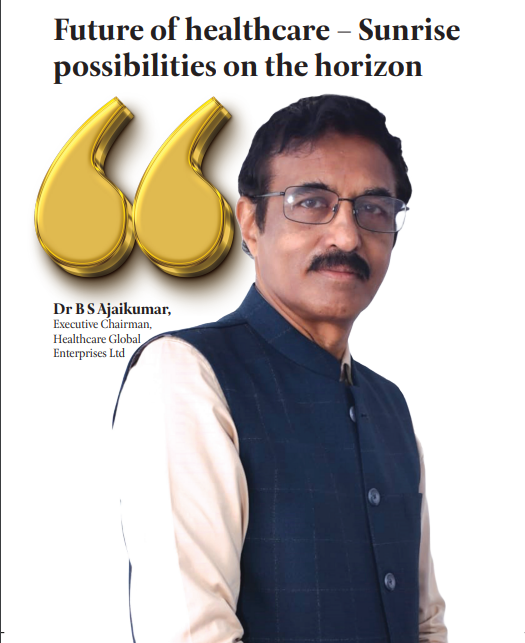
Future of healthcare – Sunrise possibilities on the horizon
We are happy to share that our Executive Chairman Dr. B S Ajaikumar's opinion article on Future of Healthcare: Sunrise possibilities on the horizon has been featured in Medical Buyer print and online Edition.
In the article, our chairman shares insights on how the Indian healthcare has been a mixed bag of the good, bad and the ugly. There’s a lot on both sides that merits either a deeper probe or a wakeup call towards moving up the value chain of excellence and innovation. How technology has helped in cancer staging and adopting a multi-disciplinary approach to cancer care. Genomics and molecular diagnostics have been the torch bearers of early detection as also precision medicine, helping clinicians provide the right treatment, the very first time. Going forward, we should see many breakthroughs in robotic surgery, laser therapies, extended reality, molecular targeted imaging, digital pathology, and cellular immuno-oncology therapy. The value chain of technology will dramatically reduce the divide between bench and bedside. Doctors will be able to study key patterns emerging out of biological and clinical data to make early interventions tailored to individual patient needs. Artificial Intelligence will help make diagnosis accurate, minimize relapse risks, and reduce mortality rates. We are not far from the day when customized cancer vaccines and gene editing will attain mass level. The diversity of omics - genomics, proteomics, metabolomics, transcriptomics and radiomics - will institutionalize precision medicine.
Dr. Ajai further highlights the flip side, on how nothing much has changed even after 75 years since independence. India is still a country of two bewilderingly different nations: one comprised of affluent and middle-class people with access to quality healthcare facilities, and the other made up of deprived individuals at the bottom of the pyramid, who have no option but to avail of second-rate healthcare. The quality of healthcare penetration in Tier 2 and 3 cities remains a glaring concern in India. The doctor-patient ratio is heavily tilted in favor of urban areas despite the growing demand for quality healthcare services in Tier 2 and 3 cities across all communicable and non-communicable diseases. Our towns and villages are perennially deprived of professionally managed and well-equipped hospitals. No surprise that competent doctors, nurses, administrative and housekeeping staff, and healthcare activists are not willing to work in these areas in their search for better employment prospects.
He adds policy making will vastly improve if the government constitutes an advisory body comprising domain experts, technocrats, research scholars, and government officials to discuss and decide what’s best for the sector. Among other things, the government must create an endowment fund for funding critical healthcare schemes and initiatives. It can raise substantial funds by monetizing impaired assets, selling off unused real estate, and divesting stakes in loss-making ventures. Once the corpus is built, purposeful withdrawals can be made from the investment income of the fund.
To access the complete PDF, please click here :
Medical Buyer - September 2024
To access the complete article, click on the below link: